========================================================================
Cybernetics in the 3rd Millennium (C3M) Volume 10 Number 1, March 2012
Alan B. Scrivener — www.well.com/user/abs — mailto:abs@well.com
========================================================================
In this issue:
Yet Another Reboot
Dear friends, the last year — in fact, altogether the current millennium —
has been rough over here at my house, and I have neglected C3M in favor of
more mundane survival activities. But the future is looking up, finally,
and I believe I can resume my schedule of an issue every other month.
Stay tuned.
Short Subjects: Old and New Cybernetic Gizmos;
Reading List; a Translation
 Arduino circuit board by Wayne Holder
Arduino circuit board by Wayne Holder
"I find clutter, in my personal environment, oppressive.
But crazed environments of dead tech and poignant rubbish
turn up in my fiction on a regular basis, where they are
usually presented as being at once comforting, evocative
and somehow magical. The future as flea market."
— William Gibson "My Obsession" 1999, WIRED Magazine
reprinted in "Distrust That Particular Flavor" collected essays, 2012
(
www.amazon.com/exec/obidos/ASIN/039915843X/hip-20 )
K3 Hardware Doc.
I find this meticulous documentation of "ELECTRONIC ANALOG COMPUTING
INSTRUMENTS" from the early 1950s fascinating.
(
www.philbrickarchive.org )
(
www.philbrickarchive.org/k3_series_components.htm )
The Ubiquitous Arduino
If you want to build a hobbyist gizmo of almost any type these days,
you need to learn about the Arduino.
(
en.wikipedia.org/wiki/Arduino )
My old friend Wayne Holder has been writing hobbyist articles on this
topic lately:
(
sites.google.com/site/wayneholder/attiny-4-5-9-10-assembly-ide-and-programmer )
IEC-1131 - The First Universal Process Control Language
According to the on-line magazine
Process Engineering Control and Maintenance,
(
www.webmags.co.uk/mag.aspx?magcode=PECM_Jul_Aug_2011 )
as of 2003 the state of the art in process control for professional
applications is using programmable logic controllers programmed in the
international standard language
IEC 61131-3
(
en.wikipedia.org/wiki/IEC_61131-3 )
(
www.automation.com/resources-tools/articles-white-papers/process-control-process-monitoring/iec-1131-the-first-universal-process-control-language )
Octave: Free Math Laboratory Software
I have been getting a lot of good use out of the open source desktop software
Octave, a Matlab work-alike, which is available on many platforms.
(
www.math.uic.edu/~hanson/Octave/OctaveODE-EG.html )
Servo Magazine
My friend Steve Price, who's been doing a lot of volunteer work lately with high school
kids building robots, says
Servo is a useful magazine for robotics hobbyists,
especially the ads in the back.
(
www.servomagazine.com )
Reading List
The following are books I have read in the last year, and recommend, but
don't have time now to review:
- Glenn Clark The Man Who Tapped the Secrets of the Universe (biography, 1946)
( www.amazon.com/exec/obidos/ASIN/1879605074/hip-20 )
- William York Tindall A Reader's Guide to James Joyce (criticism, 1959)
( www.amazon.com/exec/obidos/ASIN/0815603207/hip-20 )
- Isaac Asimov Asimov's Guide to the Bible: the Old and New Testaments (1969)
( www.amazon.com/exec/obidos/ASIN/051734582X/hip-20 )
- Isaac Asimov Of Matters Great and Small (1975)
( www.amazon.com/exec/obidos/ASIN/0441610722/hip-20 )
- Otto Mayr The Origins of Feedback Control (1975)
( www.amazon.com/exec/obidos/ASIN/0262630567/hip-20 )
- Shakti & Marcus Reunion: Tools for Transformation (1976)
( www.amazon.com/exec/obidos/ASIN/0931432014/hip-20 )
- Fan Chung & Ron Graham Erdös On Graphs: His Legacy of Unsolved Problems (1998)
( www.amazon.com/exec/obidos/ASIN/1568810792/hip-20 )
- James. N. Price Railroad Stations of San Diego County: Then and Now (1998)
( www.amazon.com/exec/obidos/ASIN/096218571X/hip-20 )
- Dale W. Bell Woodstock: An Inside Look at the Movie That Shook Up the World
and Defined a Generation (1999)
( www.amazon.com/exec/obidos/ASIN/094118871X/hip-20 )
- Nancy Kilpatrick The Goth Bible: A Compendium for the Darkly Inclined (2004)
( www.amazon.com/exec/obidos/ASIN/0312306962/hip-20 )
- Malcolm Gladwell Blink: The Power of Thinking Without Thinking (2005)
( www.amazon.com/exec/obidos/ASIN/0316010669/hip-20 )
- Elliot Tiber and Tom Monte Taking Woodstock: A True Story of a Riot, a Concert,
and a Life (autobiography, 2007)
( www.amazon.com/exec/obidos/ASIN/0757002935/hip-20 )
- Cory Doctorow Overclocked: Stories of the Future Present (sci-fi short stories, 2007)
( www.amazon.com/exec/obidos/ASIN/1560259817/hip-20 )
- Malcolm Gladwell Outliers: The Story of Success (2008)
( www.amazon.com/exec/obidos/ASIN/0316017930/hip-20 )
- Stewart Brand Whole Earth Discipline: An Ecopragmatist Manifesto (2009)
( www.amazon.com/exec/obidos/ASIN/0670021210/hip-20 )
- Douglas Coupland Marshall McLuhan: You Know Nothing of My Work! (biography, 2010)
( www.amazon.com/exec/obidos/ASIN/1935633163/hip-20 )
- Randall Munroe xkcd: volume 0 (humor, 2010)
( www.amazon.com/exec/obidos/ASIN/0615314465/hip-20 )
- Gary Taubes Why We Get Fat and What To Do About It (2011)
( www.amazon.com/exec/obidos/ASIN/0307474259/hip-20 )
- William Gibson Distrust That Particular Flavor (short nonficition, 2012)
( www.amazon.com/exec/obidos/ASIN/039915843X/hip-20 )
- Bruce Sterling Gothic High-Tech (sci-fi short stories, 2012)
( www.amazon.com/exec/obidos/ASIN/1596064048/hip-20 )
A Curriculum for Cybernetics and Systems Theory in Bulgarian
Albert Ward of Plovdiv, Bulgaria, has graciously done the work to translate my
Curriculum for Cybernetics and Systems Theory
(
www.well.com/user/abs/curriculum.html )
into Bulgarian:
(
www.fatcow.com/edu/well-curriculum-bl )
Modeling ODEs In a Spreadsheet Explained In 371 Words
 Lorenz attractor visualization from Solving Ordinary Differential Equations in C++
Lorenz attractor visualization from Solving Ordinary Differential Equations in C++
(
www.codeproject.com/Articles/43607/Solving-ordinary-differential-equations-in-C )
— probably a more useful article than this one...
Intro
I've been having "issues" lately with with
terseness. As an exercise,
I've written this
extremely short article on something I know how to
do, that I think y'all could benefit from, that I've previously promised to
write about.
Text
A set of Ordinary Differential Equations (ODEs) or "change rules" expresses
the rates of change of components of a vector "X" (x1, x2, x3, ... etc.)
in terms of the current value of the vector at some time "t" we are
interested in. For example:
x1_dot = x2
x2_dot = -x3
x3_dot = x1
where "x1_dot" means "the rate of change of x1 at time t," i.e. x1'(t).
Assume vector "I" (i1, i2, i3, ... etc.) is the set of initial conditions
at time t = 0. This information taken together is what we call a "three
dimensional set of ODEs."
To solve this set of ODEs via
linear algebra (calculus year three),
consult a thick textbook of special cases — or use Wolfram Alpha.
(To make Wolfram Alpha happy I replaced x1 with x, x2 with y, and x3 with z.)
(
www.wolframalpha.com/input/?i=x%27+%3D+y%3B+y%27+%3D+-z%3B+z%27+%3D+x )
To simulate with a spreadsheet program such as Microsoft Excel or Google
Docs Spreadsheet,
(
docs.google.com )
put the initial conditions (i1, i2, i3, ... etc.) in the first row, in
the cells labeled A1, B1, C1, etc. (Letters are for columns and numbers
are for rows.) Then make the next row correspond to the ODEs:
A2: =A1 + B1 * $D$1
B2: =B1 - C1 * $D$1
C2: =C1 + A1 * $D$1
The value in cell D1 is a scaling factor, which should be between 0 and
1. (The "$" syntax anchors a link as absolute; otherwise it is relative.)
If you want N rows per time step, make the scale factor 1/N.
Next copy the second line below as many times as you want time steps,
call that S, times N. E.g., if N is 10 and S is 16 time steps, copy
the second row 160 times.
The last row will have the values of X at time t = S + 1. If you
select a column and graph it, this will show the evolution of the
selected variable over time. Adjust the scale factor for smoothness
and accuracy. Note: this approach uses "Euler's Method" which is
very approximate. If results are too approximate, see the article on
C++ cited above and use the "Fourth-Order Runga-Cutta Method" instead.
Re: Joyce
 McLuhan as Magritte painting
McLuhan as Magritte painting
"Mulligan stew for Bloom,
the only Jew in the room
Saxon's sick on the holy dregs
and their constant getting throw up on his leg.
Molly's gone to blazes,
Boylan's crotch amazes
any woman whose husband sleeps with his head
all buried down at the foot of his bed."
— Grace Slick, 1967
"Rejoyce"
"Joyce devoted his tenth and last thunder in
Finnegans Wake to TV, 'the charge of
the light barricade.' The viewer is the screen
(not the camera, as in a movie)."
— Marshall McLuhan, 1970
"Culture Is Our Business"
(
www.amazon.com/exec/obidos/ASIN/0345026950/hip-20 )
Dear readers, I thought you might like to know I've embarked on a project
to read the complete, deliberately published works of James Joyce (excluding
letters & discarded manuscripts published posthumously). So far I have
read "Dubliners" (1914) and "A Portrait of the Artist As a Young Man" (1916)
and am about 1/3 the way through "Ulysses" (1922).
Along the way I've created a few documents to help me:
- Correspondences in the Stages of the Careers of James Joyce and the Beatles
+--------------+--------------------------+----------------------+
| a new voice | Chamber Music | With the Beatles |
| | (1907) | (1963) |
| | Dubliners | Please Please Me |
| | (1914) | (1963) |
| | Stephen Hero | Beatles For Sale |
| | (1944) | (1964) |
+--------------+--------------------------+----------------------+
| a new direc- | A Portrait of the Artist | A Hard Day's Night |
| tion | As a Young Man | (1964) |
| | (1916) | Help! |
| | Exiles | (1965) |
| | (1918) | |
+--------------+--------------------------+----------------------+
| a new style | Ulysses | Rubber Soul |
| | (1922) | (1965) |
| | | Revolver |
| | | (1966) |
+--------------+--------------------------+----------------------+
| odd lot | The Cat and the Devil | Yellow Submarine |
| | (1936) | (1967) |
+--------------+--------------------------+----------------------+
| like nothing | Finnegans Wake | Sgt. Pepper's Lonely |
| even done | (1939) | Hearts Club Band |
| before | | (1967) |
| | | Magical Mystery Tour |
| | | (1967) |
| | | The White Album |
| | | (1968) |
| | | Abbey Road |
| | | (1969) |
+--------------+--------------------------+----------------------+
| scraps | Letters | Let It Be |
| | (1957) | (1970) |
| | | Past Masters |
| | | (1988) |
+--------------+--------------------------+----------------------+
- James Joyce's "Ulysses" chapters
A handy guide suitable for printing out and keeping in the book.
( www.well.com/user/abs/Cyb/archive/ulysses_chapters.html )
- Marshall McLuhan on James Joyce
A work in progress.
( www.well.com/user/abs/Cyb/archive/mcluhan_joyce.html )
Why am I doing this? Well, a number of smart and talented people have
claimed this stuff is vital. Media guru
Marshall McLuhan quotes
Joyce in just about every book he ever wrote; I haven't found an exception
yet. His "War and Peace in the Global Village" (1968)
(
www.amazon.com/exec/obidos/ASIN/B000NPDT7S/hip-20 )
(written with Quentin Fiore and Jerome Agel) is an in-depth look at Joyce's
relevance to media studies. He quotes
Finnegans Wake so often that
he saves time by just referring to it as "FW." Rock star
Grace Slick
in the above-quoted song from the Jefferson Airplane album "After Bathing At
Baxters" (1967)
(
www.amazon.com/exec/obidos/ASIN/B0000A0DRX/hip-20 )
sings the praises of
Ulysses. Audio comedy troupe
the Firesign
Theatre has been called Joycean (as has Thomas Pynchon, come to think
of it) and their album "How Can You Be in Two Places at Once When You're
Not Anywhere at All" (1969)
(
www.amazon.com/exec/obidos/ASIN/B0000024UU/hip-20 )
concludes with a direct quote from Molly Bloom's final soliloquy in "Ulysses."
Counter-culture philosopher
Robert Anton Wilson refers to Joyce
repeatedly, and his book, "Coincidance: A Head Test" (1988)
(
www.amazon.com/exec/obidos/ASIN/1561840041/hip-20 )
(with title taken from
Finnegans Wake) contains the most incisive Joyce
analysis I've seen.
Fair enough, but what does this have to do with cybernetics, you may well ask?
Before answering this question, on a lark I Googled "James Joyce cybernetics"
(
www.google.com/search?q=james+joyce+cybernetics&ie=UTF-8&oe=UTF-8&hl=en )
and found a treasure trove of stuff, including a page from the American
Society for Cybernetics called "Noted Contributors to Cybernetics and
Systems Theory"
(
www.asc-cybernetics.org/foundations/cyberneticians.htm )
which has this bio of Ernst Von Glasersfeld:
"Philosopher & Cybernetician. He spent large parts of his life in
Ireland [1940s], in Italy [1950s] and the USA [current]. Elaborating
upon Vico, Piaget's genetic epistemology, Bishop Berkeley's theory of
perception, James Joyce's Finnegans Wake and other important texts,
Ernst developed his model of Radical Constructivism — which is an
ethos shared by all of these writers to one degree or another, sometimes
it is difficult to see where their epistemological agreements begin and
end — but that is part of the fun."
Nice to know I'm not alone in seeing the relevance. But this is
cheating. The answer from my own background is that I remember
McLuhan saying in "War and Peace in the Global Village" (p. 53)
that Joyce claimed to be "the greatest engineer who ever lived."
This piqued my interest more than anything.
One thing I'm already aware of is Joyce's talent for overloading
words with meanings. Wilson deconstructs his sentence:
"It's as semper as oxhousehumper."
"Semper" is a pun on "simple" and also Latin for "always" or "eternal."
(Marine Corps.'
Semper Fidelis — always faithful.) The
phrase "It's as simple as..." is often ended "ABC." Pulling apart
"oxhousehumper" we get "ox," "house," and "humper." The original
Phoenician alphabet had what we now call "A" as a symbol for ox,
"B" as a house, and "G" (which later mutated into "C") as a camel,
complete with hump. Here we find reference to the simple yet eternal
alphabet, ancient civilizations, and a sophomoric sexual innuendo.
That's Joyce in a nutshell. (Or as he sometimes called it, a "notshall.")
The Firesigns appropriated this technique in their comedy. In the
routine "Forward Into the Past" collected on the album "Shoes
for Industry! The Best of the Firesign Theatre" (1993),
(
www.amazon.com/exec/obidos/ASIN/B0000028OU/hip-20 )
we get this sentence about World War II era wartime recycling:
"Remember, garbage that goes bad comes back at our boys in baggies!"
In the 1940s baggies were the loose pants worn by the military, our
"boys in baggies." But the 1960s audience of the Firesigns knew baggies
as plastic food storage bags, from companies like Du Pont which also
gave us body bags in Viet Nam. The allusion to our boys coming back
from the war in bags is hard to miss for a Baby Boomer. The phrase
is overloaded with meaning about changing public attitudes towards war
during the twenty year interval.
Similarly, Joyce also overloads the meaning of entire books. "Ulysses"
seems on the surface to be about a couple 'a guys wandering around Dublin
on June 16, 1904 (now known as "Bloomsday" to Joyce fans), but it is well
known that it also maps onto the Odyssey by Homer. "Finnegans Wake"
seems to be a surreal (dare I say
psychedelic) re-interpretation
of the same events in 1904, but according to McLuhan it also maps onto a
history of disruptive technology from the Paleolithic to the electronic,
including television as it was known in 1939.
(
en.wikipedia.org/wiki/War_and_Peace_in_the_Global_Village )
More on this exploration as it unfolds.
License To Kill — Some Thoughts On the Assassination of Bin Laden
 this news photo of South Viet Nam's dictator Nguyen
executing a prisoner of war without trial enraged American
liberals in the 1960s
this news photo of South Viet Nam's dictator Nguyen
executing a prisoner of war without trial enraged American
liberals in the 1960s
"We are lucky men, for we have a cause worth dying for.
This honor is not given to every generation."
— Esther Forbes, 1943
"Johnny Tremain" (novel)
(
www.amazon.com/exec/obidos/ASIN/1580930166/hip-20 )
I grew up watching Walt Disney's live-action entertainment on his
Sunday night TV show. I learned about patriotism and human rights
from episodes such as
The Scarecrow of Romney Marsh,
Swamp
Fox, and
Johnny Tremain. Set in England and Colonial America,
these stories put a human face on the struggle of our ancestors to
achieve freedom. In
Johnny Tremain (1957),
(
www.amazon.com/exec/obidos/ASIN/B00005JM6F/hip-20 )
based on the 1943 novel by Esther Forbes,
(
www.amazon.com/exec/obidos/ASIN/1580930166/hip-20 )
a young man joins the American revolution for the excitement, and
then later learns about the principles it is based on. One night
at a Philadelphia inn he begs to be allowed to deliver refreshments
to a meeting of the "Sons of Liberty" and overhears patriarch James
Otis answering the question, "For what will we fight?" The dialog
comes almost verbatim from Forbes' book:
'To free Boston from these infernal redcoats and...'
'No,' said Otis. '...that's not enough reason for going
into a war...I hate those infernal British troops spread
all over my town as much as you do. Can't move these days
without stepping on a soldier. But we are not going off
into a civil war merely to get them out of Boston. Why are
we going to fight? Why? Why?'
There was an embarrassed silence. Sam Adams was the
acknowledged ringleader. It was for him to speak now.
'We will fight for the rights of Americans. England cannot
take our money away by taxes.'
'No, no. For something more important than the pocketbooks
of our American citizens.'
(Enter Rab): 'For the rights of Englishmen — everywhere.'
'Why stop with Englishmen?' Otis was warming up. ...'For
men and women and children all over the world,' he said.
'You were right, [Rab], for even as we shoot down the
British soldiers we are fighting for rights such as they
will be enjoying a hundred years from now. ... there shall
be no more tyranny. A handful of men cannot seize power
over thousands. A man shall choose who it is shall rule over
him. ... the peasants of France, the serfs of Russia. Hardly
more than animals now. But because we fight, they shall see
freedom like a new sun rising in the west. Those natural
rights God has given to every man, no matter how humble...'
He smiled suddenly and said, ...'or crazy,'...
These stories taught me that winning of our freedoms has been
a long, historical process. That's why I'm alarmed to see
apparent reversals of history recently.
But before I step squarely into the middle of partisan fire,
let me talk first about somebody else, somewhere else.
Remember the Siege of Sarajevo, "the longest siege of a
capital city in the history of modern warfare?"
(
en.wikipedia.org/wiki/Siege_of_Sarajevo )
That siege began in early May of 1992. Were you alive then?
Where were you? There were riots going on in Los Angeles,
the space shuttle Endeavor made its first trip into orbit,
the America's Cup races were going on in San Diego, the last
episode of Golden Girls" aired on TV, Altman's "The Player"
and dog movie "Beethoven" were big at the box office, and
on the radio "My Lovin' (Never Gonna Get It)" by En Vogue and
"Under the Bridge" by the Red Hot Chili Peppers were in heavy
rotation.
The siege was lifted nearly four years later, in February of
1996. Remember that time? Garry Kasparov was in a chess battle
with an IBM computer named "Deep Blue." Snoop Dogg and his
bodyguard were acquitted of first degree murder. At the 38th
Grammy Awards: Alanis Morisette won for "Jagged Little Pill."
That was a pretty eventful four years in the U.S. It was
Clinton's first term. Windows '95 came out and the internet
got big suddenly, and computing was getting cheaper very quickly.
We were riding the growth curve that became the dot-com boom.
And rumbling along in the background, there was that siege in
Sarajevo.
Wikipedia says: "It is estimated that nearly 10,000 people were
killed or went missing in the city, including over 1,500 children.
An additional 56,000 people were wounded, including nearly 15,000
children."
Jeepers, that's nearly a 9/11 a year for four years.
A city of 525,980 having 66,000 killed or wounded --
the Romans had a word for that: they called it being
decimated.
(
en.wikipedia.org/wiki/Decimation_%28Roman_army%29 )
So why did so few care in the West? Well, by unhappy accident
the conflict wasn't on anybody's Powerpoint presentations in
Washington as part of a Democratic or Republican push for
anything, so it remained invisible. The fact that the good
guy were Moslem and the bad guys were Christian probably didn't
help either. For a while it seemed like only the super-band
U2 adopted this cause, with their song and video "Miss Sarajevo."
(
www.youtube.com/watch?v=cuEt7EvPMVU )
Wikipedia tells us: "'Miss Sarajevo' is the only single
from the 1995 album
Original Soundtracks 1 by U2
and Brian Eno, under the pseudonym Passengers. Luciano
Pavarotti makes a guest vocal appearance, singing the
opera solo. ... While the song did not reach the Billboard
Hot 100, it reached #6 on the UK Singles Chart and was a
top-ten hit in many other European countries. Bono cites
'Miss Sarajevo' as his favorite U2 song."
( http://en.wikipedia.org/wiki/Miss_Sarajevo )
At 5:44 in the video you see the Miss Sarajevo Pageant contestants
with a banner -- in English -- reading "DON'T LET THEM KILL US."
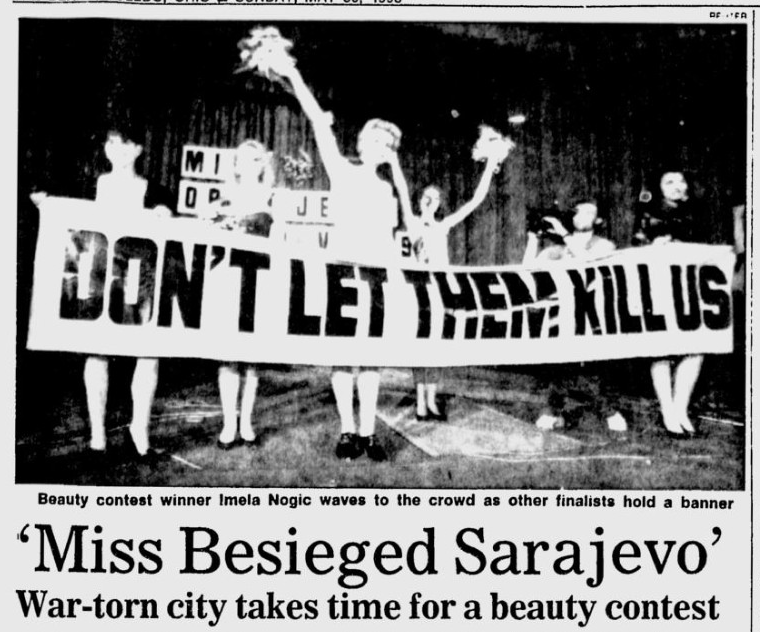 surreal scene from the Bosnian Genocide
surreal scene from the Bosnian Genocide
This pageant was a publicity stunt, based on the principle
that sex sells, with a polite request for rescue from
genocidal extinction.
My own cynical theory is this: the 1998 Winter Olympics in Nagano,
Japan were coming up,
(
en.wikipedia.org/wiki/Nagano_Olympics )
and it began to dawn on the administration that every time somebody
on TV mentioned the 1984 Winter Olympics in Sarajevo,
(
en.wikipedia.org/wiki/Sarajevo_Olympics )
they were going to show pictures of the current day city, with the Olympic
facilities destroyed by bombs, and mention that it was still under siege.
That became the deadline.
 Olympic village in ruins
Olympic village in ruins
As a result, we and NATO waged a rather miraculous "air war"
in which none of our guys got hurt, and Sarajevo was saved.
Before we move on from this happy ending, I'd like to,
hypothetically, ask, what advice would we have given to
the citizens of Sarajevo in 1992, when the siege began?
Be patient? The system will work eventually?
What if they'd wanted to suspend their own human rights principles and
go after their enemies with indefinite detention and torture? Would we
advise them not to do it, not to give up their own humanity in their fury?
Sure we would've. Talk is cheap.
But it was different in America after 9/11. Suddenly it was
us being
attacked. We who hadn't had a strike on our mainland, virtually,
since the British burned the White House, meaning before modern
warfare. It was different when it was
us.
And, to get technical for a minute, what kind of philosophy is it that
makes
me more important than
you, merely by virtue of
being
me?
I'd call that
solipsism,
(
en.wikipedia.org/wiki/Solipsism )
the belief that only I exist. Among modern thinkers, it is probably
best exemplified by the scandalous Frenchman we know as the Marquis de Sade.
(
en.wikipedia.org/wiki/Marquis_de_sade )
His reputation has been softened up by recent practitioners of a sexual
flavor called "BDSM" often associated with the slogan "Safe, Sane and
Consensual." Wikipedia calls it an "erotic preference."
(
en.wikipedia.org/wiki/Bdsm )
Celebrities from Madonna to Rihanna have "flogged" this style.
(Sorry.)
But the original Marquis was far less Safe, Sane and Consensual.
He believed his pleasures came first, and were a human right just
because he said so. I'm trying to point out how ugly this seems
when it's somebody else doing it.
I think I'm ready to drag the Republicans and Democrats into this.
In the Washington power-grab right after 9/11, the Republican
administration of George W. Bush pushed through the Patriot Act,
nuking a bunch of our rights, and invented Enemy Combatants,
an Orwellian Twilight-Zone category between civilian and soldier,
along with the Twilight-Zone-like Guantanamo Bay facility, run
by our military on the edge of a communist enemy power. The
Democratic administration of Barack Obama, after some hemming
and hawing, has decided it likes the previous power grabs, and
has added a presidential "license to kill." This seemed so
sexy when James Bond was doing it, but the important thing to
recognize is that by granting a government agent this license
we're throwing away Habeas Corpus rights going back to the twelfth
century, even before the Magna Carta.
(
en.wikipedia.org/wiki/Habeas_corpus )
For half a millennium English kings lacked the power to have someone
killed without a judge being in the loop, and now the world's first
true democracy looks to let that one slip away without a fight...
I've mentioned before, in C3M vol. 4 no. 5, that "I for one am grateful
for [George] Lucas giving us the wonderful line in [Star Wars] Episode II,
spoken by Senator Amidala:
So this is how liberty dies, with thunderous applause.
If we remember it, it may someday help us to save our republic."
(
www.well.com/user/abs/Cyb/archive/c3m_0405.html )
* * * * * *
I actually began writing this essay right after Bin Laden's assasination,
but before the subsequent "hit" on cleric Anwar al-Awlaki.
(
www.washingtontimes.com/news/2011/sep/30/ron-paul-cleric-al-awlaki-assassinated )
I was planning on saying that I found the administration's plans for
al-Awlaki even more troubling than the Bin Laden mission. This man,
an American citizen, was targeted for death for his
speech. How do
you get on the list to get offed by Uncle Sam? An undisclosed person
puts your name on an undisclosed list, and other undisclosed persons
then fail to remove it.
I'm reminded of some chilling imagery in the Soviet era exposé of
communist tyranny, "The Gulag Archipelago" (novel, 1973) by
Aleksandr Solzhenitsyn.
(
www.amazon.com/exec/obidos/ASIN/1843430851/hip-20 )
He describes how when the U.S.S.R.'s secret police, the KGB, dragged
someone away in the night, they would drag away a neighbor as a "witness"
to satisfy now-vestigial laws designed to guard citizens' rights. The
only remaining function of this was to terrorize the neighbor.
He wanted to remind us how spooky the ghosts of rights could be.
The Radiant City:
What I Learned About Bucky Fuller,
EPCOT and the Moderns While Researching
Virtual Worlds
 Le Corbusier's Radiant City (unbuilt)
Le Corbusier's Radiant City (unbuilt)
"The characteristic question of the day: where will you find the money?"
— Le Corbusier
quoted by B. Korshunov
Stroitelnaia Promyshlennos 3, no. 12 (1925)
The last time I wrote about architecture, two people called me verbose and
one of them unsubscribed. I guess I'm just bursting with things to say about
the topic, and once again I have too much material for the short essay I've
planned, so I will focus on being on-message. Here goes...
Building Virtual Worlds
 a city view in Sundog: Frozen Legacy
a city view in Sundog: Frozen Legacy
"You know, the only way I've found to make these places is with animators
— you can't seem to do it with accountants and bookkeepers."
— Walt Disney
quoted in "Animation: Form Follows Fun" (2004)
by Regina Dahmen-Ingenhoven
(
www.amazon.com/exec/obidos/ASIN/3764366338/hip-20 )
As reported here before, I've been working on a project to port a classic
Apple ][ game, "Sundog: Frozen Legacy" to the iPhone.
(
en.wikipedia.org/wiki/SunDog:_Frozen_Legacy )
(
www.gamefaqs.com/ast/952333-sundog-frozen-legacy/images/box-110518 )
The original game had scores of cities on dozens of planets, all represented
as two-dimensional grids as in the screen shot above. For the new "reboot" we
have been planning to have fully 3D cities. The problem is the sheer amount
of work required to create all the solid models of buildings, especially if
they are to look like they represent a variety of cultures. One of the ways
we are exploring to address this is to have buildings defined procedurally,
(
en.wikipedia.org/wiki/Procedural_generation )
but that will only help us get results faster, it won't tell us what
results we need to get. In casting about for inspiration, I remembered
a book I borrowed from my friend Will A. years ago, called "Yesterday's
Tomorrows: Past Visions of the American Future" (1984) by Corn & Horrigan.
(
www.amazon.com/exec/obidos/ASIN/0801853990/hip-20 )
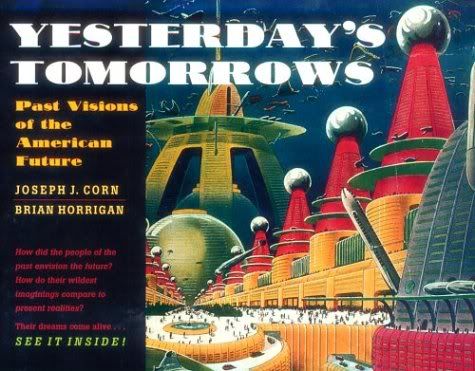 Past Visions of the American Future
Past Visions of the American Future
It chronicles changing visions of "the future" in recent U.S. history.
I thought some of these "obsolete futures" might be useful sources
of city ideas.
Then I remembered something in Tom Wolfe's popular book on architecture,
"From Bauhaus To Our House" (1981).
(
www.amazon.com/exec/obidos/ASIN/055338063X/hip-20 )
Describing the career arc of French modernist Le Corbusier, Wolfe says,
"Le Corbusier. Mr Purism. He showed everybody how to become a famous
architect without building buildings. He built a Radiant City inside
his skull."
and shows a photo of Corbu in his trademark owl glasses, pontificating.
Wolfe was referring to the unbuilt design for the
Ville Radieuse,
or Radiant City, for a major Moscow redevelopment — later a similar
concept was created for Paris.
(
http://www.google.com/search?q=Ville+Radieuse&hl=en )
"That's it!" I thought. I recalled that many of the pioneers of Modernism
had grand plans for huge futuristic cities that were mostly unbuilt.
Since you can't copyright architrecture, I thought this was our chance to
strip-mine the history of the future. For each type of utopian vision,
we could have families of cities in similar style, with stylistically
similar buildings forming the stores, taverns, banks, hotels, warehouses,
monuments, and other city components.
(In most cases it was certainly a blessing that these designs weren't built,
replacing large historic districts, but there's plenty of real estate in
cyberspace!)
So I set out to study these utopian visions:
- Le Corbuser's Radiant City (see picture above)
- Frank Lloyd Wright's Broadacre City
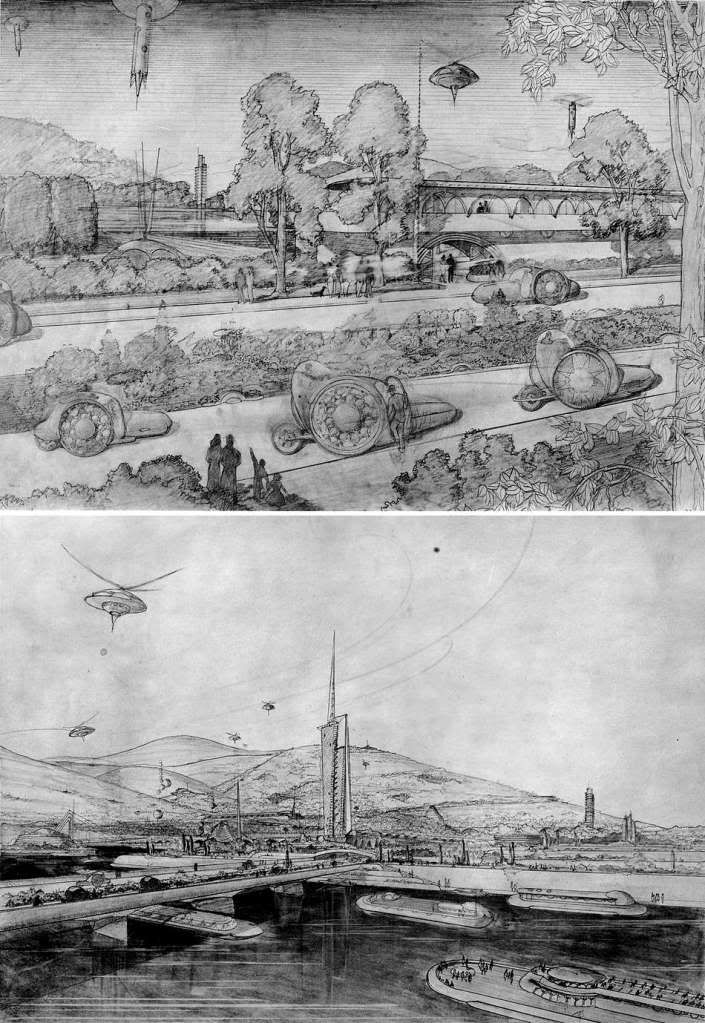 Wright sought a "prairie Architecture"
( en.wikipedia.org/wiki/Broadacre_City )
Wright sought a "prairie Architecture"
( en.wikipedia.org/wiki/Broadacre_City )
- Mies Van Der Rohe's Alexanderplatz design for Berlin
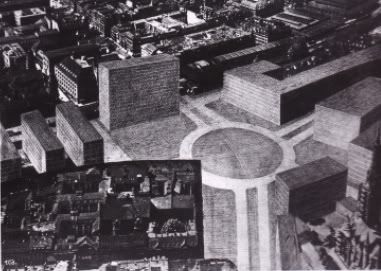 Mies Van Der Rohe's Alexanderplatz (unbuilt)
Mies Van Der Rohe's Alexanderplatz (unbuilt)
- Irving Gill's plan for Torrance (partially built and now partially gone)
 Irving Gill designed portions of "workers paradise" Torrance, California
Irving Gill designed portions of "workers paradise" Torrance, California
- Victor Gruen's regional shopping center and urban core renewal designs
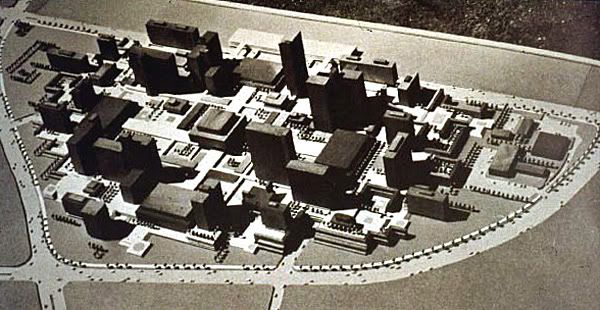 Valencia core model by Gruen
Valencia core model by Gruen
- Walt Disney's design for An Experimental Prototype Community of Tomorrow (EPCOT)
 Victor Gruen's urban planning inspired Walt Disney's E.P.C.O.T.
Victor Gruen's urban planning inspired Walt Disney's E.P.C.O.T.
- Bucky Fuller's giant land, air & ocean cities
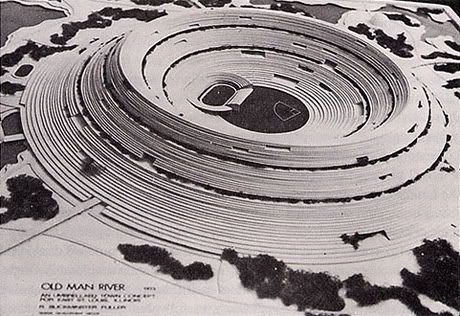 "Old Man River's City" designed by Fuller for East Saint Louis
"Old Man River's City" designed by Fuller for East Saint Louis
Along the way a learned a few fascinating things not directly connected
with my virtual worlds project which I'd like to share with you all.
21st Century Moderns
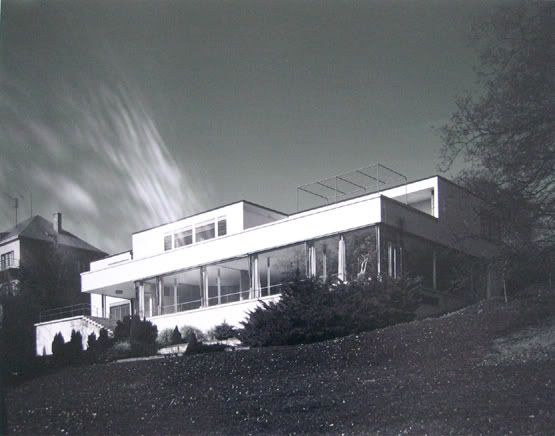 Tugendhat House photographed by Thomas Ruff
Tugendhat House photographed by Thomas Ruff
"The Tugendhat House was occupied by the family for little more
than seven years. The family emigrated in 1938 in the run-up to the
Nazi- German invasion. As 'unappropriated Jewish property' the house
was confiscated by the National Socialists and registered in 1942 in
the estate register as property of the Reich; during the war it housed
occasionally a design office of the aircraft engine company 'Ostmark,'
but by then the ebony wall and the Lehmbruck sculpture had already
vanished. In 1945 the Red Army took quarters in the villa. In 1950
the house became property of the Czechoslovakian state and used as an
institute for physiotherapy. In 1963 the Villa was declared cultural
monument, restored in 1985, and in 2001 listed in the UNESCO International
Cultural and National Heritage list."
— Claire Zimmerman, 2006
"Mies Van Der Rohe 1886 - 1969 The Structure of Space"
It's customary to put the bibliography at the end of an article,
but I'm going to wedge it in here, because I have a point to make.
Below is the list of books I've read so far for this project.
You'll notice that almost all of them were published in the last
dozen years. The only exceptions are books by the architects
themselves, and a few surveys which have been re-issued in the
21st century.
There seems to be growing interest in what is now called "Mid-
Century Modern" style. Another example is the restoration of Mies
Van Der Rohe's Tugendhat House in the quote and picture above.
Perhaps this is just a case of "don't know what you've got 'till
it's gone," but I see a lot more interest now than 40 years ago.
Here, then, is the book list:
Pure Functionalism As Just Another Aesthetic
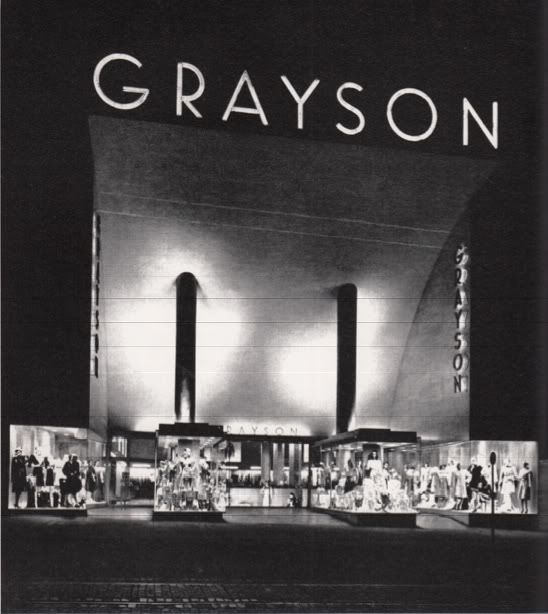 attack of the 50-foot store window by Gruen
attack of the 50-foot store window by Gruen
"The evolution of culture is synonymous with the removal of ornament
from objects of daily use." This idea should have given rise to a
new joy but it gave rise to sadness at ornaments not being produced.
Objects without ornament in the past were carelessly thrown away,
and any rubbish with the smallest ornament was collected and displayed.
Every period had a style, which meant ornament. Our period however
does not: it is important because it cannot produce new ornament,
has out-grown ornament. The streets will now glow like white walls.
— Adolf Loos, 1908
"Ornament and Crime"
"We have now become aware of the possibility
of arranging the entire human environment
as a work of art."
— Marshall McLuhan, 1968
"The Medium Is the Massage"
(
www.amazon.com/exec/obidos/ASIN/B0000CO31L/hip-20 )
It's tempting to take an aesthetic approach in analyzing these works.
Architecture is, after all, considered an art form, at least partially.
But we quickly encounter the paradox that "pure functionalism" can
so easily devolve into just another aesthetic.
Wikipedia tells us about Walter Gropius, founder of the Bauhaus
School, waging a successful campaign to influence his fellow
architects with a new functionalist aesthetic.
"In 1913, Gropius published an article about 'The Development of Industrial
Buildings,' which included about a dozen photographs of factories and grain
elevators in North America. A very influential text, this article had a
strong influence on other European modernists, including Le Corbusier and
Erich Mendelsohn, both of whom reprinted Gropius's grain elevator pictures
between 1920 and 1930."
(
en.wikipedia.org/wiki/Walter_Gropius )
(Some critics have pointed out that most of these buildings had annexes
attached in front for managers' offices, done in popular styles such as
Neoclassical, Italianate, Spanish Colonial, Streamline Moderne, and Art
Deco. "The Silver Fox" as they called him, just went around back to take
the pictures of the unadorned industrial buildings. Also, it's worth
noting that as we speak, Disney is retrofitting the Main Street in its
California Adventure theme park in Anaheim to have new buildings in many
of these styles added, to invoke a re-creation of Hollywood in the 1920s
and '30s.)
(
www.kcet.org/updaily/socal_focus/history/la-as-subject/how-disney-imagineers-recreated-1920s-and-1930s-la-in-21st-century-anaheim.html )
But it's not hard to sympathize with the original impulses of modernism.
Styles such as Victorian and Queen Anne had become so ornate and baroque,
it was a widely-held wish to simplify things and start with a clean
slate, which led to the Arts and Crafts Movement, the Craftsman Style,
and California architectural pioneer Irving Gill's attempts to scrape
all the "Churrigueresque" deally-bobs and flourishes off of the Mission
Revival style to make it a collection of arches, arcades, flat roofs
and plain plaster walls.
 La Jolla Women's Club by Irving Gill, 1913
La Jolla Women's Club by Irving Gill, 1913
My interest in Gill lead me to Adolf Loos, an early Austrian modernist
who was apparently the first to sing the praises of Gill's work to
European architecture magazine readers. Loos is most famous for
an essay called "Ornament and Crime" (1908), which was highly influential
with other architects worldwide. He made a moral argument against ornament,
saying it was okay for primitives like New Guinea islanders who tattoo
their bodies, but us moderns have evolved past that. He really hammers the
point:
The Papuan tattoos his skin, his boat, his oar, in short, everything
that is within his reach. He is no criminal. The modern man who
tattoos himself is a criminal or a degenerate. There are prisons
where eighty percent of the inmates bear tattoos. Those who are
tattooed but are not imprisoned are latent criminals or degenerate
aristocrats. If a tattooed person dies at liberty, it is only that
he died a few years before he committed a murder.
In an odd way he has a point. One sign of the great culture turn
on the "hinge of history" that occurred with the advent of Post-Modernism
in the 1970s and '80s was the resurgence of interest in body art among
the non-degenerate. Chroniclers of the
avant-garde in the
high art world reported on this in the "Re/Search" series book "Modern
Primitives" (1989) by V. Vale, et. al.
(
www.amazon.com/exec/obidos/ASIN/0965046931/hip-20 )
As an avowed Post-Modernist myself, I have railed against the anti-
ornament stance of the Moderns since at least 1985. Imagine my surprise,
then, when I found during my latest research that the Moderns actually
for the most part designed really pleasant and beautiful single family
homes.
Just this year I have been engaging in a hobby called "Gill Walking,"
which combines walking for exercise with photographing houses in
San Diego county designed (or co-designed) by Irving Gill, and then
posting the pictures for my Facebook friends.
 a typical "Gill Walking" post on Facebook (Windermere
Cottage, top row center, has since been demolished)
a typical "Gill Walking" post on Facebook (Windermere
Cottage, top row center, has since been demolished)
One thing I noticed was that the Gills often stood out. His later solo
works, especially buildings that haven't been heavily modified, stand
out, even on the tony streets of San Diego's historic neighborhoods.
They look well-designed, livable, and have a Zen-like simple elegance.
Gill believed in modern theories of hygiene, sunlight, ventilation,
not unlike Florence Nightingale, and favored indoor-outdoor living
and easily cleaned unadorned surfaces. His ideas suit Southern
California. Most of his homes are nicely gardened, a practice he
loudly encouraged:
"We should build our house simple, plain and substantial as a boulder,
then leave the ornamentation of it to Nature, who will tone it with
lichen, chisel it with storms, make it gracious and friendly with
vines and flower shadows as she does the stone in the meadow."
(Writing the Craftsman Magazine in 1916.)
As I read the book list above, I found in the profuse illustrations proof
that the other Moderns similarly designed impressive homes.
Loos used small, cozy, split-level rooms and half-staircases to create
a veritable maze of rooms in 3D, and terraced them on the outside to
provide an indoor-outdoor living experience.
Mies developed the open plan, allowing more flexible space use, and
emphasizing the simplicity of the overall design.
Le Corbusier also favored indoor-outdoor spaces with ambigouos transitions
between the interior and nature.
It was when these architects began designing skyscrapers that things
got weird. As Tom Wolfe explains in "...Bauhaus..." (op. cit.):
"Every great law firm in New York moves without a sputter of protest
into a glass-box office building with concrete slab floors and
seven-foot-ten-inch-high concrete slab ceilings and plasterboard
walls and pygmy corridors — and then hires a decorator and gives him
a budget of hundreds of thousands of dollars to turn these mean
cubes and grids into a horizontal fantasy of a Restoration townhouse.
I have seen the carpenters and cabinetmakers and search-and-acquire
girls hauling in more cornices, covings, pilasters, carved moldings,
and recessed domes, more linenfold paneling, more (fireless)
fireplaces with festoons of fruit carved in mahogany on the mantels,
more chandeliers, sconces, girandoles, chestnut leather sofas, and
chiming clocks than Wren, Inigo Jones, the brothers Adam, Lord
Burlington, and the Dilettanti, working in concert, could have dreamed
of. Without a peep they move in! — even though the glass box
appalls them all."
The other hinky thing was that the Moderns used an aesthetic approach
called "expressed structure" intended to make buildings more honest.
Not totally honest, mind you, just more honest. Wolfe makes a big
deal out of Mies' Seagram Building in New York. He'd wanted to leave
the structural I-beams unsheathed in cement, but fire laws forbade
it, so he additional,
ornamental I-beams stuck on the outside
of the building.
 "expressed structure" in the Seagram Building, New York (1958)
"expressed structure" in the Seagram Building, New York (1958)
So, ornament is okay as long as it's "functional looking" enough?
No indictment of Modernism is complete without mentioning the book
"Form Follows Fiasco: Why Modern Architecture Hasn't Worked" (1978)
by Peter Blake.
 failure modes of "form follows function"
failure modes of "form follows function"
(
www.amazon.com/exec/obidos/ASIN/0316099392/hip-20 )
Blake shows how Modern Architecture fails by its own standards; when
a flat-roof, no-overhang box has "Nature ... chisel it with storms"
the result is too often water damage, roof collapse, etc. Somehow things
got turned around and "functional style" ended up lacking in functionality.
Against this failure of both aesthetics and functionality, it is
useful to contrast the work of Bucky Fuller. It seems to me from where
the sun stands now that, by their own standards, Bucky was the greatest
Modernist. He used to say that he didn't consider aesthetics at all
while he worked on a design, but when it was done, if it wasn't beautiful,
he knew he'd done something wrong.
From this last batch of reading, I learned that neither architects nor
engineers liked to hang out with him. Artists instead seemed to prefer
his company most, and when he lived in a New York loft and threw rooftop
parties a number of famous ones came. In fact, the architects were quick
to point out that he wasn't one of them, as were the engineers, and one
way to interpret his life, which he called "Guinea Pig B," is as a work
of performance art. Like "environmental artists" such as Christo, Fuller
made his life a "demo" redefining the interface between humans and nature.
He practiced what he called "Anticipatory Design Science" as a lifestyle.
I also learned that Fuller began his geodesic explorations while evolving
what became the Dymaxion Map. An early version was based on an unfolded
cuboctahedron, which later was replaced by an icosahedron.
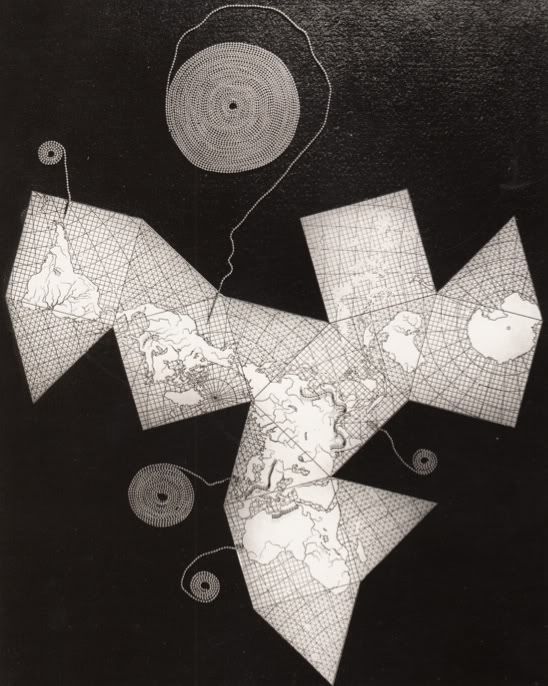 early Dymaxion Map with squares and triangles
early Dymaxion Map with squares and triangles
This project inspired him to apply geodesics to shelter problems,
and the domes were the results. He was like an artist moving from 2D
drawing to 3D sculpting. I find his designs incredibly beautiful
(though I know this is a controversial opinion), and their goals
are always efficiency, "more with less."
The Geometry of Infrastructure
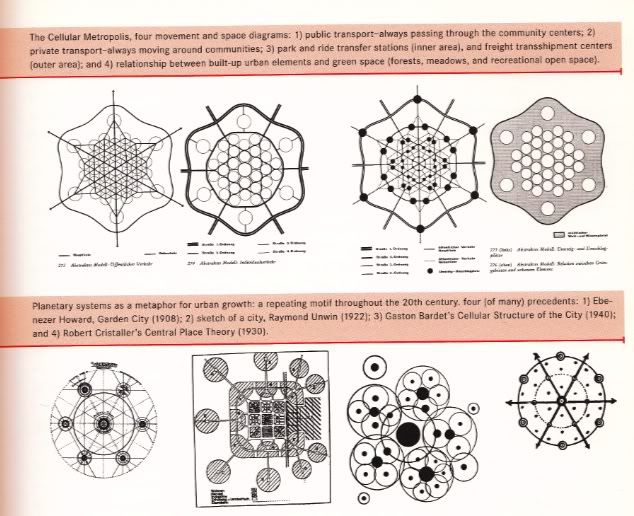 Victor Gruen on city cell planning and evolution
Victor Gruen on city cell planning and evolution
"We're riding on the escalator of life,
We're shopping at the human mall."
— Robert Hazard, 1982
"Escalator of Life"
(
www.amazon.com/exec/obidos/ASIN/B0000033B3/hip-20 )
(
http://www.youtube.com/watch?v=wIT2DpdcPzI )
Robert Venturi, the scholastic architect who pushed us into Post-
Modernism, once described a nearly ideal building as a "decorated shed."
(He later upgraded his vision to a shed covered with pixels, the building
as HDTV.) The shed part comes from the fact that, in the age of steel,
our "best" all-purpose building design is the hangar or warehouse, with
a pitched roof for runoff. Clearly any decoration (or pixels) are to be
applied after the fact. No letting the ornament department mess with the
engineering specs.
It wasn't always thus. The early Moderns in the 1920s and '30s saw
themselves as engineers. Somehow, by the 1970s, engineering had split
off entirely and had assumed the uneasy role of saying yes or no to the
crazy architects. For example, in 1966-73 the prestigious modern
architect Minoru Yamasaki designed the World Trade Center, and then
the engineering firm of Worthington, Skilling, Helle & Jackson told
him whether they could build it. They invented "a new structural model:
a rigid 'hollow tube' of closely spaced steel columns with floor
trusses extended across to a central core," and were able to say "yes."
(
www.skyscraper.org/TALLEST_TOWERS/t_wtc.htm )
I'm not at all clear when or how this transition took place; it probably
had something to do with the Moderns getting into skyscrapers after World
War II. But it is quite fascinating to look at the engineering innovations
originally pioneered by early modern architects.
* * * * * *
One of the things Irving Gill developed and demonstrated was the "tilt-up"
concrete construction method, which he used for small homes mostly, but are
now a "default" design for small commercial/industrial buildings in
Western Civilization.
(
en.wikipedia.org/wiki/Tilt_up )
* * * * * *
As mentioned above, Mies Van Der Rohe pioneered the "open plan," utilizing
the new steel frame construction of modern buildings to dispense with interior
walls. As Zimmerman (op. cit.) tells it:
"...he achieved significant results at the Stuttgart exhibition: his
apartment block at the Weissenhofsiedlung, with a load bearing steel
frame construction, contained apartments with nonstructural partition
walls, which produced potentially flexible grounds plans."
Only a few case-study homes were built this way, but it became the template for the
modern commercial office building and its sea of "cubes."
* * * * * *
Le Corbusier was a champion of forced-air heating, cooling and ventilation in
buildings. I've come to realize that he saw the limits of an old paradigm. Consider
the Bradbury Building in Los Angeles, designed by pre-modernist George Wyman.
 Bradbury building (1893) atrium
Bradbury building (1893) atrium
It's a beautiful building, everybody loves it, been in many movies and shows,
"Outer Limits," "Blade Runner," bla bla bla.
(
en.wikipedia.org/wiki/Bradbury_Building )
But its basic design — three or four stories (I forget), offices on the outer walls
with windows, and the whole roof a skylight to illuminate the atrium — just won't
scale much. Embassy Suites Hotels have about pushed it to the limit, while
"wasting" a lot of interior space. That glass roof is tough on energy use
in severe climates, too.
Corbu realized that to build larger buildings it would be necessary for some rooms
to not have exterior windows. What he called the "environment exact" was a program
to introduce new ventilation technology to allow larger structures. He also collaborated
with the visionaries who wanted to build the first "sleep lab" as a kind of panopticon
for sleeping Soviet citizens, to aid in the optimization of their slumber.
In addition he did groundbreaking design work in acoustics and crowd flow management
for the unbuilt "Palace of Soviets" in Moscow; its final shape was determined, from the
inside out, by these concerns.
* * * * * *
Perhaps the most remarkable infrastructure work I was exposed to in my reading was
by Vienna-born Victor Gruen, father of the modern regional shopping mall. I will never
look at a shopping center the same way again.
I first became aware of Gruen's work from Disney fan blogs, in which I learned
— as I mentioned above — that Walt got many of the ides for E.P.C.O.T. (the
unbuilt city, not the theme park) from the work of Victor Gruen.
(
micechat.com/blogs/samland/1771-walt-disneys-epcot-heart-our-cities.html )
(
micechat.com/blogs/samland/1777-epcot-heart-our-cities-part-two.html )
Gruen's most innovative ideas come from his infrastructure work, not any aesthetic
or anti-aesthetic positions. I used to look at a shopping center and ask myself what
style it was in: Classical Revival, Modern, Post-Modern, Deconstructionist or what have
you. Now, thanks to Gruen, I ask: "How do the trucks deliver the goods to the stores?"
Gruen developed a taxonomy of mall design based on whether the trucks came in the
same way as the cars, or around back, or underneath.
Gruen also argues, like Corbu, that — short of "getting rid of" populations somehow —
you can have high density or you can have sprawl, and density is better. (Stewart Brand
revisits this argument in "Whole Earth Discipline," op. cit.)
Gruen drew upon his Vienna roots to analyze how high-density city centers remain relevant.
By his appraisal, old town Vienna has lacked sound economic or logistical reasons for
existing for a long time, but due to cultural "baggage" (in a good way) persists as a vital
civic core. He aimed to recreate that legacy somehow in regional shopping centers. He
argued to developers that only by having spelling bees, fashion shows and ballet recitals
(etc.) in a mall could you create the urban heart he sought. Actually, I don't think he had
the right answers, but he was asking the right questions. Unfortunately, the "new mall"
phenomenon — in which shoppers flee old centers for the latest and greatest — ending up
making urban zombies of his early work.
(
http://www.core77.com/reactor/deadmalls.asp )
* * * * * *
Of course, we've always known that Bucky Fuller was mainly interested in function,
not form. My reading of "Buckminster Fuller: Designing for Mobility" (2005) by Michael
John Gorman (op. cit.) revealed that he'd always been interested in
mobility in
architecture. Perhaps realizing that whether by plate tectonics or solar nova, all places are
doomed to be destroyed and we must be a mobile species, all of his work has pushed
in that direction. I had never given it much thought that I have seen lots of the works
of the other moderns, especially Gill and Gruen, but very few of Fuller's. It's because
his structures are designed to be temporary. They pop up at world's fairs (EXPO '67),
theme parks (EPOCOT Center), playgrounds, as high-tech mountaineering tents (REI), and
at big outdoor music venues (Coachella) and art events (Burning Man).
Don't Blame the Avant-Garde For the Dogma Fifty Years Later
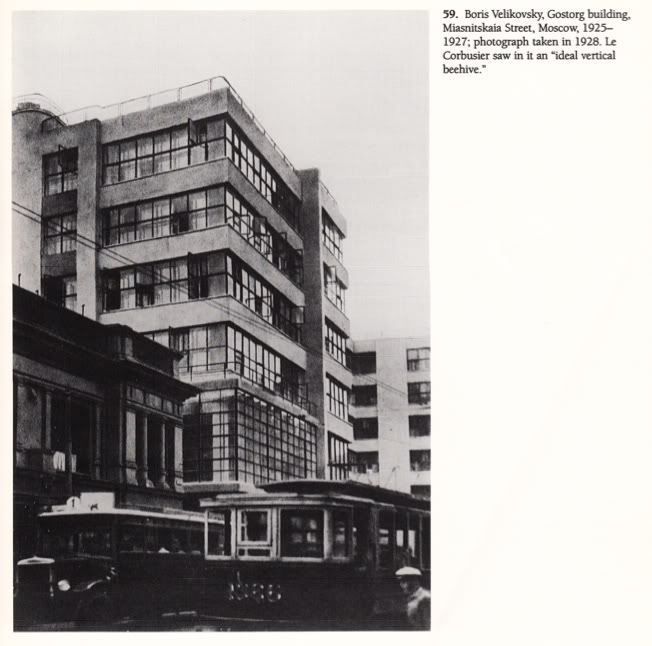 Soviet architecture praised by Le Corbusier
Soviet architecture praised by Le Corbusier
"Because of its pure geometric shape, its flat roofs and its overall
white appearance, opponents of the new style ridiculed it as 'Arabville'
and 'Bolshevist Barracks.'"
— Claire Zimmerman, 2006
"Mies Van Der Rohe 1886 - 1969 The Structure of Space"
So how do we grade the moderns with the hindsight of history? I'd say they were best
at what they claimed to be up to, following function to form, and worst at
scalability
and at applying their covert "functionalist" aesthetic agenda. (These are two areas
where Bucky beats them cold at their own game.)
But I admire them more for their courage, and their hardship. Just because architecture spent
fifty years following in their footsteps doesn't mean they ever had it very easy while alive.
Mies originally sold his services to the new German government in the 1930s, because
he was mister "new," and none of the traditionalists would deal with him. Of course that
was the new Nazi government. Eventually they stopped employing him because he wasn't
Nazi enough, and later he fled to America, where he was occasionally accused of having Nazi
architectural ideas.
Corbu was also mister "new" in France, and had trouble getting Paris traditionalists interested
in his work. He did some gigs in the Soviet Union (and had trouble getting paid, alas)
but then they stopped using him because he wasn't Communist enough. Upon his return to
France, and later flight to America, he was occasionally accused of having Communist
architectural ideas.
(It certainly didn't help things that the Soviet government tore down a historic Russian
Orthodox cathedral, "Christ the Savior," for the site of the Palace of Soviets that
Corbu was competing to design, but I never saw any evidence that he knew this.)
Though Gruen was financially successful he was made a pariah as the inventor of the mall.
No matter that he repudiated the design and focused on center city renewal with projects
like the Fulton Mall pedestrian zone in downtown Fresno, California.
(
http://www.youtube.com/watch?v=bdTS_LLJvcw )
The damage was done. He had once envisioned the architect as a sort of renaiasance man
urban planner, businessman, engineer, artist, sociologist, traffic flow designer and banking
expert. But the developers cherry-picked his ideas and routed around him. As Alex Wall
(op. cit) explains:
In the dense mixed-use environment of the historic core of Vienna that had
modeled so much of Gruen's thinking, commerce, culture, and all other human
activities were woven together. As architects lost their leading role in
shopping-center development, however, Gruen believed that subsequent projects
were stripped of their social and cultural functions, transformed into a
formula by developers and their institutional investors, and then replicated
countless times across the American landscape. Far from identifying and
serving the needs of an existing community, developers knew that people
would flock to the giant shopping center, whether it had social and
cultural facilities or not, and no matter what the distance to existing
communities.
Perhaps it's lucky Mies wasn't alive to see the cultural dissing his work received from
Prince Charles, who opposed Modernism but in a way that made me thing he wanted to
go back to 19th Centuryy excesses. Mies designed the "Mansion House Square and
Office Tower" in 1967 for a lot that wouldn't be available until 1986. By then Prince
Charles had stopped the project. And yet this unbuilt building has its own Facebook page in 2012.
(
www.facebook.com/media/set/?set=a.10150345249085379.389921.56200560378&type=1 )
I guess the bottom line is that I no longer blame the Moderns for Modernism. As I said in the
headline of this final section, "Don't blame the
avant-garde for the dogma fifty years later."
It is the mediocre and the cowardly who gave us a fifty-year empire of Modernism as an "ism."
Those who defied the norm were vilified by fellow architects and other cultural critics.
Wolfe (op. cit.) describes the careers of Eero Saarinen
(
en.wikipedia.org/wiki/Eero_Saarinen )
and John Portman
(
en.wikipedia.org/wiki/John_Portman )
as "apostates," and to that list I would add Welton Beckett.
(
en.wikipedia.org/wiki/Welton_Becket )
He was very successful and designed many of my favorite buildings in Southern California,
and yet I'd never heard of him until I was Googling theme park architecture just last year and
found he'd designed Disney's Contemporary Resort in Lake Buena Vista, Florida (1971).
The world of "serious" architecture seemed to have "disappeared" him.
What all the architects I've named in this essay have in common is courage, and think
we need more courageous architects. Robert Venturi, with his Judo-trick of post-Modernism,
has provided some cover for those who wish to expand the frontiers of architecture, but
who knows how long that will last in this deconstructed era, and anyway, it's no substitute for courage.
Note Re:
"If It's Just a Virtual Actor, Then Why Am I Feeling Real Emotions?"
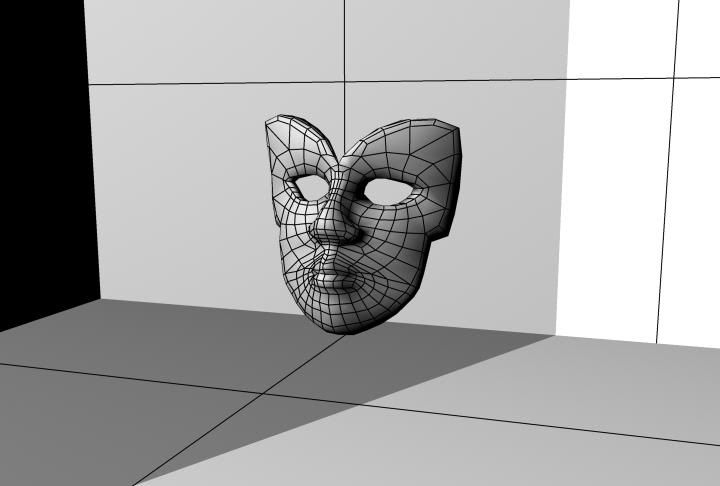
Part four of this serialization will appear next time.
Comments On Comments
In our last episode I introduced a comments widget from Facebook as an
experimental way for you all to comment, non-anonymously. I am now
abandoning this experiment, for the following reasons:
- Almost none of you used it. The only commenter was off-topic, asking for
help tracking down some information which no-one replied to.
- The total number of comments I got via email also dropped dramatically.
- Facebook broke the widget, as near as I can tell.
So, as before, if you have feedback, email me. (My address is in the header
at the top.) Be aware I may quote you in this 'Zine.
Keep those cards and letters coming in!
========================================================================
newsletter archives:
www.well.com/user/abs/Cyb/archive
========================================================================
Privacy Promise: Your email address will never be sold or given to
others. You will receive only the e-Zine C3M from me, Alan Scrivener,
at most once per month. It may contain commercial offers from me.
To cancel the e-Zine send the subject line "unsubscribe" to me.
~~~~~~~~~~~~~~~~~~~~~~~~~~~~~~~~~~~~~~~~~~~~~~~~~~~~~~~~~~~~~~~~~~~~~~~~
I receive a commission on everything you purchase from Amazon.com after
following one of my links, which helps to support my research.
========================================================================
Copyright 2012 by Alan B. Scrivener
Last update:
Sun Mar 4 19:15:04 PST 2012
 Arduino circuit board by Wayne Holder
Arduino circuit board by Wayne Holder
 Lorenz attractor visualization from Solving Ordinary Differential Equations in C++
( www.codeproject.com/Articles/43607/Solving-ordinary-differential-equations-in-C )
— probably a more useful article than this one...
Lorenz attractor visualization from Solving Ordinary Differential Equations in C++
( www.codeproject.com/Articles/43607/Solving-ordinary-differential-equations-in-C )
— probably a more useful article than this one...
 McLuhan as Magritte painting
McLuhan as Magritte painting
 this news photo of South Viet Nam's dictator Nguyen
executing a prisoner of war without trial enraged American
liberals in the 1960s
this news photo of South Viet Nam's dictator Nguyen
executing a prisoner of war without trial enraged American
liberals in the 1960s
 surreal scene from the Bosnian Genocide
This pageant was a publicity stunt, based on the principle
that sex sells, with a polite request for rescue from
genocidal extinction.
My own cynical theory is this: the 1998 Winter Olympics in Nagano,
Japan were coming up,
( en.wikipedia.org/wiki/Nagano_Olympics )
and it began to dawn on the administration that every time somebody
on TV mentioned the 1984 Winter Olympics in Sarajevo,
( en.wikipedia.org/wiki/Sarajevo_Olympics )
they were going to show pictures of the current day city, with the Olympic
facilities destroyed by bombs, and mention that it was still under siege.
That became the deadline.
surreal scene from the Bosnian Genocide
This pageant was a publicity stunt, based on the principle
that sex sells, with a polite request for rescue from
genocidal extinction.
My own cynical theory is this: the 1998 Winter Olympics in Nagano,
Japan were coming up,
( en.wikipedia.org/wiki/Nagano_Olympics )
and it began to dawn on the administration that every time somebody
on TV mentioned the 1984 Winter Olympics in Sarajevo,
( en.wikipedia.org/wiki/Sarajevo_Olympics )
they were going to show pictures of the current day city, with the Olympic
facilities destroyed by bombs, and mention that it was still under siege.
That became the deadline.
 Olympic village in ruins
As a result, we and NATO waged a rather miraculous "air war"
in which none of our guys got hurt, and Sarajevo was saved.
Before we move on from this happy ending, I'd like to,
hypothetically, ask, what advice would we have given to
the citizens of Sarajevo in 1992, when the siege began?
Be patient? The system will work eventually?
What if they'd wanted to suspend their own human rights principles and
go after their enemies with indefinite detention and torture? Would we
advise them not to do it, not to give up their own humanity in their fury?
Sure we would've. Talk is cheap.
But it was different in America after 9/11. Suddenly it was us being
attacked. We who hadn't had a strike on our mainland, virtually,
since the British burned the White House, meaning before modern
warfare. It was different when it was us.
And, to get technical for a minute, what kind of philosophy is it that
makes me more important than you, merely by virtue of
being me?
I'd call that solipsism,
( en.wikipedia.org/wiki/Solipsism )
the belief that only I exist. Among modern thinkers, it is probably
best exemplified by the scandalous Frenchman we know as the Marquis de Sade.
( en.wikipedia.org/wiki/Marquis_de_sade )
His reputation has been softened up by recent practitioners of a sexual
flavor called "BDSM" often associated with the slogan "Safe, Sane and
Consensual." Wikipedia calls it an "erotic preference."
( en.wikipedia.org/wiki/Bdsm )
Celebrities from Madonna to Rihanna have "flogged" this style.
(Sorry.)
But the original Marquis was far less Safe, Sane and Consensual.
He believed his pleasures came first, and were a human right just
because he said so. I'm trying to point out how ugly this seems
when it's somebody else doing it.
I think I'm ready to drag the Republicans and Democrats into this.
In the Washington power-grab right after 9/11, the Republican
administration of George W. Bush pushed through the Patriot Act,
nuking a bunch of our rights, and invented Enemy Combatants,
an Orwellian Twilight-Zone category between civilian and soldier,
along with the Twilight-Zone-like Guantanamo Bay facility, run
by our military on the edge of a communist enemy power. The
Democratic administration of Barack Obama, after some hemming
and hawing, has decided it likes the previous power grabs, and
has added a presidential "license to kill." This seemed so
sexy when James Bond was doing it, but the important thing to
recognize is that by granting a government agent this license
we're throwing away Habeas Corpus rights going back to the twelfth
century, even before the Magna Carta.
( en.wikipedia.org/wiki/Habeas_corpus )
For half a millennium English kings lacked the power to have someone
killed without a judge being in the loop, and now the world's first
true democracy looks to let that one slip away without a fight...
I've mentioned before, in C3M vol. 4 no. 5, that "I for one am grateful
for [George] Lucas giving us the wonderful line in [Star Wars] Episode II,
spoken by Senator Amidala:
So this is how liberty dies, with thunderous applause.
If we remember it, it may someday help us to save our republic."
( www.well.com/user/abs/Cyb/archive/c3m_0405.html )
Olympic village in ruins
As a result, we and NATO waged a rather miraculous "air war"
in which none of our guys got hurt, and Sarajevo was saved.
Before we move on from this happy ending, I'd like to,
hypothetically, ask, what advice would we have given to
the citizens of Sarajevo in 1992, when the siege began?
Be patient? The system will work eventually?
What if they'd wanted to suspend their own human rights principles and
go after their enemies with indefinite detention and torture? Would we
advise them not to do it, not to give up their own humanity in their fury?
Sure we would've. Talk is cheap.
But it was different in America after 9/11. Suddenly it was us being
attacked. We who hadn't had a strike on our mainland, virtually,
since the British burned the White House, meaning before modern
warfare. It was different when it was us.
And, to get technical for a minute, what kind of philosophy is it that
makes me more important than you, merely by virtue of
being me?
I'd call that solipsism,
( en.wikipedia.org/wiki/Solipsism )
the belief that only I exist. Among modern thinkers, it is probably
best exemplified by the scandalous Frenchman we know as the Marquis de Sade.
( en.wikipedia.org/wiki/Marquis_de_sade )
His reputation has been softened up by recent practitioners of a sexual
flavor called "BDSM" often associated with the slogan "Safe, Sane and
Consensual." Wikipedia calls it an "erotic preference."
( en.wikipedia.org/wiki/Bdsm )
Celebrities from Madonna to Rihanna have "flogged" this style.
(Sorry.)
But the original Marquis was far less Safe, Sane and Consensual.
He believed his pleasures came first, and were a human right just
because he said so. I'm trying to point out how ugly this seems
when it's somebody else doing it.
I think I'm ready to drag the Republicans and Democrats into this.
In the Washington power-grab right after 9/11, the Republican
administration of George W. Bush pushed through the Patriot Act,
nuking a bunch of our rights, and invented Enemy Combatants,
an Orwellian Twilight-Zone category between civilian and soldier,
along with the Twilight-Zone-like Guantanamo Bay facility, run
by our military on the edge of a communist enemy power. The
Democratic administration of Barack Obama, after some hemming
and hawing, has decided it likes the previous power grabs, and
has added a presidential "license to kill." This seemed so
sexy when James Bond was doing it, but the important thing to
recognize is that by granting a government agent this license
we're throwing away Habeas Corpus rights going back to the twelfth
century, even before the Magna Carta.
( en.wikipedia.org/wiki/Habeas_corpus )
For half a millennium English kings lacked the power to have someone
killed without a judge being in the loop, and now the world's first
true democracy looks to let that one slip away without a fight...
I've mentioned before, in C3M vol. 4 no. 5, that "I for one am grateful
for [George] Lucas giving us the wonderful line in [Star Wars] Episode II,
spoken by Senator Amidala:
So this is how liberty dies, with thunderous applause.
If we remember it, it may someday help us to save our republic."
( www.well.com/user/abs/Cyb/archive/c3m_0405.html )
 Le Corbusier's Radiant City (unbuilt)
Le Corbusier's Radiant City (unbuilt)
 a city view in Sundog: Frozen Legacy
a city view in Sundog: Frozen Legacy
 Past Visions of the American Future
It chronicles changing visions of "the future" in recent U.S. history.
I thought some of these "obsolete futures" might be useful sources
of city ideas.
Then I remembered something in Tom Wolfe's popular book on architecture,
"From Bauhaus To Our House" (1981).
( www.amazon.com/exec/obidos/ASIN/055338063X/hip-20 )
Describing the career arc of French modernist Le Corbusier, Wolfe says,
Past Visions of the American Future
It chronicles changing visions of "the future" in recent U.S. history.
I thought some of these "obsolete futures" might be useful sources
of city ideas.
Then I remembered something in Tom Wolfe's popular book on architecture,
"From Bauhaus To Our House" (1981).
( www.amazon.com/exec/obidos/ASIN/055338063X/hip-20 )
Describing the career arc of French modernist Le Corbusier, Wolfe says,
 Wright sought a "prairie Architecture"
( en.wikipedia.org/wiki/Broadacre_City )
Wright sought a "prairie Architecture"
( en.wikipedia.org/wiki/Broadacre_City )
 Mies Van Der Rohe's Alexanderplatz (unbuilt)
Mies Van Der Rohe's Alexanderplatz (unbuilt)
 Irving Gill designed portions of "workers paradise" Torrance, California
Irving Gill designed portions of "workers paradise" Torrance, California
 Valencia core model by Gruen
Valencia core model by Gruen
 Victor Gruen's urban planning inspired Walt Disney's E.P.C.O.T.
Victor Gruen's urban planning inspired Walt Disney's E.P.C.O.T.
 "Old Man River's City" designed by Fuller for East Saint Louis
"Old Man River's City" designed by Fuller for East Saint Louis
 Tugendhat House photographed by Thomas Ruff
Tugendhat House photographed by Thomas Ruff
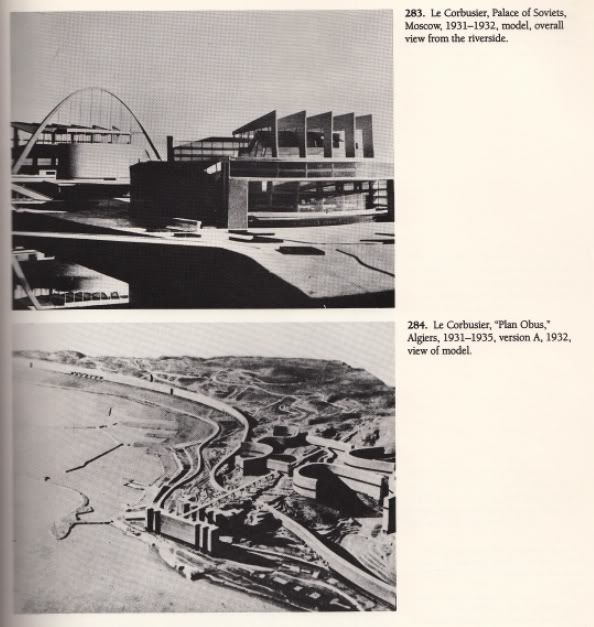



 attack of the 50-foot store window by Gruen
attack of the 50-foot store window by Gruen
 La Jolla Women's Club by Irving Gill, 1913
My interest in Gill lead me to Adolf Loos, an early Austrian modernist
who was apparently the first to sing the praises of Gill's work to
European architecture magazine readers. Loos is most famous for
an essay called "Ornament and Crime" (1908), which was highly influential
with other architects worldwide. He made a moral argument against ornament,
saying it was okay for primitives like New Guinea islanders who tattoo
their bodies, but us moderns have evolved past that. He really hammers the
point:
La Jolla Women's Club by Irving Gill, 1913
My interest in Gill lead me to Adolf Loos, an early Austrian modernist
who was apparently the first to sing the praises of Gill's work to
European architecture magazine readers. Loos is most famous for
an essay called "Ornament and Crime" (1908), which was highly influential
with other architects worldwide. He made a moral argument against ornament,
saying it was okay for primitives like New Guinea islanders who tattoo
their bodies, but us moderns have evolved past that. He really hammers the
point:
 a typical "Gill Walking" post on Facebook (Windermere
Cottage, top row center, has since been demolished)
One thing I noticed was that the Gills often stood out. His later solo
works, especially buildings that haven't been heavily modified, stand
out, even on the tony streets of San Diego's historic neighborhoods.
They look well-designed, livable, and have a Zen-like simple elegance.
Gill believed in modern theories of hygiene, sunlight, ventilation,
not unlike Florence Nightingale, and favored indoor-outdoor living
and easily cleaned unadorned surfaces. His ideas suit Southern
California. Most of his homes are nicely gardened, a practice he
loudly encouraged:
a typical "Gill Walking" post on Facebook (Windermere
Cottage, top row center, has since been demolished)
One thing I noticed was that the Gills often stood out. His later solo
works, especially buildings that haven't been heavily modified, stand
out, even on the tony streets of San Diego's historic neighborhoods.
They look well-designed, livable, and have a Zen-like simple elegance.
Gill believed in modern theories of hygiene, sunlight, ventilation,
not unlike Florence Nightingale, and favored indoor-outdoor living
and easily cleaned unadorned surfaces. His ideas suit Southern
California. Most of his homes are nicely gardened, a practice he
loudly encouraged:
 "expressed structure" in the Seagram Building, New York (1958)
So, ornament is okay as long as it's "functional looking" enough?
No indictment of Modernism is complete without mentioning the book
"Form Follows Fiasco: Why Modern Architecture Hasn't Worked" (1978)
by Peter Blake.
"expressed structure" in the Seagram Building, New York (1958)
So, ornament is okay as long as it's "functional looking" enough?
No indictment of Modernism is complete without mentioning the book
"Form Follows Fiasco: Why Modern Architecture Hasn't Worked" (1978)
by Peter Blake.
 early Dymaxion Map with squares and triangles
This project inspired him to apply geodesics to shelter problems,
and the domes were the results. He was like an artist moving from 2D
drawing to 3D sculpting. I find his designs incredibly beautiful
(though I know this is a controversial opinion), and their goals
are always efficiency, "more with less."
early Dymaxion Map with squares and triangles
This project inspired him to apply geodesics to shelter problems,
and the domes were the results. He was like an artist moving from 2D
drawing to 3D sculpting. I find his designs incredibly beautiful
(though I know this is a controversial opinion), and their goals
are always efficiency, "more with less."
 Victor Gruen on city cell planning and evolution
Victor Gruen on city cell planning and evolution
 Bradbury building (1893) atrium
It's a beautiful building, everybody loves it, been in many movies and shows,
"Outer Limits," "Blade Runner," bla bla bla.
( en.wikipedia.org/wiki/Bradbury_Building )
But its basic design — three or four stories (I forget), offices on the outer walls
with windows, and the whole roof a skylight to illuminate the atrium — just won't
scale much. Embassy Suites Hotels have about pushed it to the limit, while
"wasting" a lot of interior space. That glass roof is tough on energy use
in severe climates, too.
Corbu realized that to build larger buildings it would be necessary for some rooms
to not have exterior windows. What he called the "environment exact" was a program
to introduce new ventilation technology to allow larger structures. He also collaborated
with the visionaries who wanted to build the first "sleep lab" as a kind of panopticon
for sleeping Soviet citizens, to aid in the optimization of their slumber.
In addition he did groundbreaking design work in acoustics and crowd flow management
for the unbuilt "Palace of Soviets" in Moscow; its final shape was determined, from the
inside out, by these concerns.
Bradbury building (1893) atrium
It's a beautiful building, everybody loves it, been in many movies and shows,
"Outer Limits," "Blade Runner," bla bla bla.
( en.wikipedia.org/wiki/Bradbury_Building )
But its basic design — three or four stories (I forget), offices on the outer walls
with windows, and the whole roof a skylight to illuminate the atrium — just won't
scale much. Embassy Suites Hotels have about pushed it to the limit, while
"wasting" a lot of interior space. That glass roof is tough on energy use
in severe climates, too.
Corbu realized that to build larger buildings it would be necessary for some rooms
to not have exterior windows. What he called the "environment exact" was a program
to introduce new ventilation technology to allow larger structures. He also collaborated
with the visionaries who wanted to build the first "sleep lab" as a kind of panopticon
for sleeping Soviet citizens, to aid in the optimization of their slumber.
In addition he did groundbreaking design work in acoustics and crowd flow management
for the unbuilt "Palace of Soviets" in Moscow; its final shape was determined, from the
inside out, by these concerns.
 Soviet architecture praised by Le Corbusier
Soviet architecture praised by Le Corbusier
 Part four of this serialization will appear next time.
Part four of this serialization will appear next time.